Author: Marshall Schott
I find it near impossible to objectively identify what makes a beer universally good or bad. A disgusting infected ale to one is a delicious Flemish Red to another, that overly hopped pine tar at the pub is someone else’s favorite IPA. I’m convinced we all perceive things differently, or at the very least, that there’s no good way to measure whether we all perceive things similarly, and I’m hardly willing to accept theory as fact.
Of course, there are always some exceptions…
Over the last few years, I’ve engaged in numerous conversations with other homebrewers about a topic that seems to have become a sensitive subject for some folks. There actually aren’t many things in this hobby I believe to be set-in-stone, in fact one of the the things I really enjoy about homebrewing is how so many people can do so many different things to produce so many different versions of a quality product. One claim I’ve made that’s resulted in shit being thrown at me is that malt extract has a particular identifiable taste that comes through in a finished beer. I don’t pass judgement on extract users or the beers they make, I actually sort of appreciate the flavor it imparts for the nostalgia I experience when I taste it. While I personally prefer the flavors in beers made with all-grain, I’m certainly not against anyone who chooses to use extract as a part of their brewing process. What I am not a big fan of are claims of certainty without any evidence to back those claims up, even if small-scale and anecdotal.
So during one of the aforementioned conversations, another brewer claimed that modern extracts were made in such a way that if integrated into the brewing liquor correctly, it would taste exactly the same as an all-grain beer made with the same malts. I questioned this, he challenged me, and I accepted. Prior to embarking on this endeavor, I thought it would be interesting to ask a bunch of homebrewers about how they got started in the hobby. Of over 850 respondents to a survey I distributed last month, a not so surprising 81% reported they began homebrewing by using either extract with steeping grains (59%) or extract only (22%), something I tend to believe is more a function of the homebrewing zeitgeist than anything else. Interestingly, nearly the same number of respondents (79%) reported all-grain as their current method.
| PURPOSE |
To evaluate the similarities and potential differences between 2 beers made using the exact same base malt, one all liquid malt extract and the other all-grain.
My purpose in writing this most definitely is not to belittle those folks who use extract, incite any sort of blue-eyed/brown-eyed contentiousness, or even convince extract users to switch to all-grain. I don’t give two shits how anyone chooses to make their beer, I’d drink it happily regardless of where the fermentables came from (within reason)! My point is to have fun evaluating a claim I’ve heard touted over the years, specifically that one can make the same exact beer using either extract as they can with all-grain. I wasn’t necessarily interested in proving which method makes the better beer, we’ll leave that to each individual beer drinker.
| METHODS |
In order to keep the variables as restricted as possible, I planned to use an extra light malt extract, research the grain used to produce that extract, then match those percentages on my system to achieve the same original gravity. I was unaware of any malt extracts made from a single base grain, all seemed to contain some amount of Munich, Vienna, and/or Crystal malt. I then discovered MoreBeer recently became an exclusive vendor of Liquid Malt Extract made from 100% Crisp Maris Otter Malt. Coincidentally, I recently purchased a sack of Crisp Floor Malted Maris Otter that I’ve been using in my brewery. What better way to test the differences between extract and all-grain than to make 2 beers using the “same” base malt? A plan was born.
Two beers were designed with an expected OG of 1.052 using 8 lbs MO extract in one and 10.25 lbs MO grain in the other. The hop schedule was as follows:
25 IBU Magnum @ 60 minutes
20 g US Fuggles @ 30 minutes (7 IBU)
20 g US Fuggles @ 05 minutes (2 IBU)
20 g US Fuggles @ flameout w/ 15 minute steep (3 IBU)
Each received 1 tsp Irish Moss at 5 minutes left in the boil. A single rehydrated pack of Danstar Nottingham yeast was pitched into each batch in order to reduce any potential problems caused by differences in pitch rate.
Quick note: the biggest difference at this point was price per batch with the extract costing me just over $28, while the grains came out to just under $11.00 (purchased in bulk).
I opted to start the extract batch first knowing that it would finish about an hour before the the AG batch, which had to be mashed.
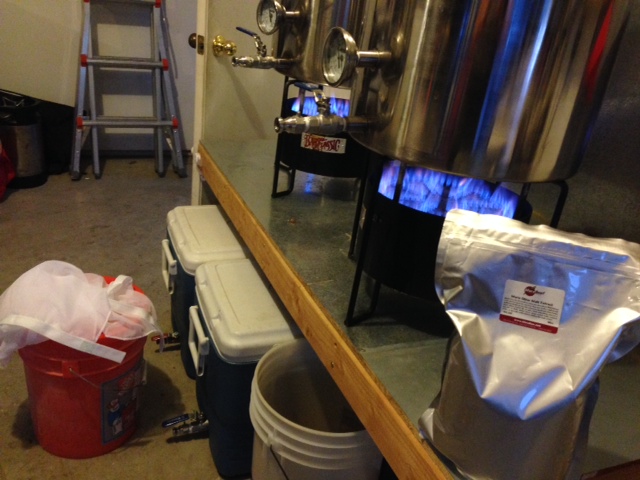
After doing some research and asking around, I determined that adding half of the extract at the start of the boil and the other half at 15 minutes was considered good practice. I collected my water, heated it to just about 200°F, turned the flame off to eliminate the risk of scorching, and added half of the extract. I’m admittedly neurotic and absolutely hate sticky messes, something I do not miss at all about using malt extract.
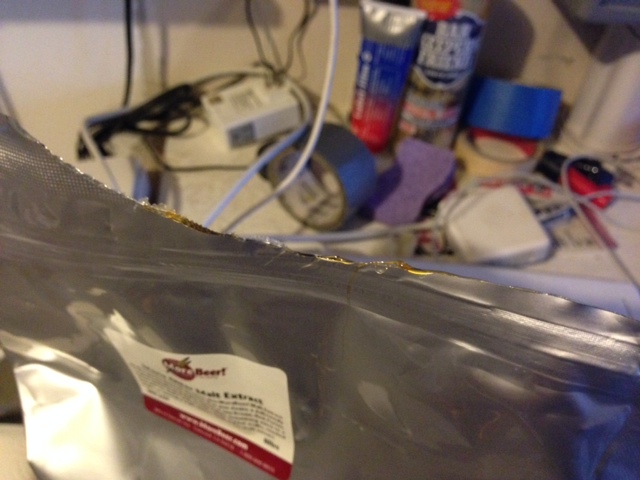
Once the first dose of extract was added, I stirred with vigor and turned the flame back on to bring it to a boil.
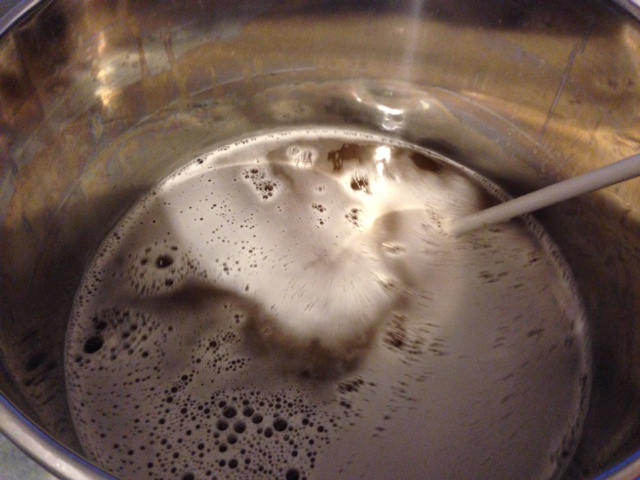
Having not used LME in years, the smell took me back to those bitter cold nights in Bellingham, Waxwing or Modest Mouse blasting through the speakers while my buddy and I brewed odd concoctions in our tiny apartment kitchen. Great memories, indeed. It wasn’t unpleasant, not at all.
About halfway through the boil, I started the AG batch using the BIAB method.
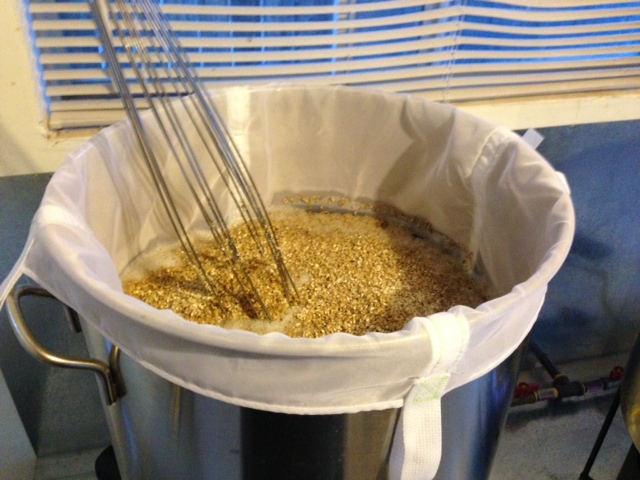
Using BeerSmith, I determined the mash temp would have to be 156°F to produce a beer with a similar finishing gravity as the extract batch. After an hour long mash, I turned the heat on and pulled the bag out, leaving behind a very pale sweet wort.
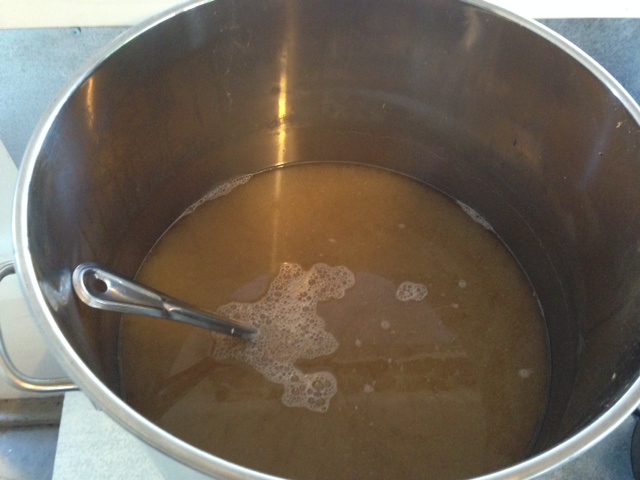
The extract batch finished while the AG batch was boiling, so I quickly chilled it and put it in a carboy.
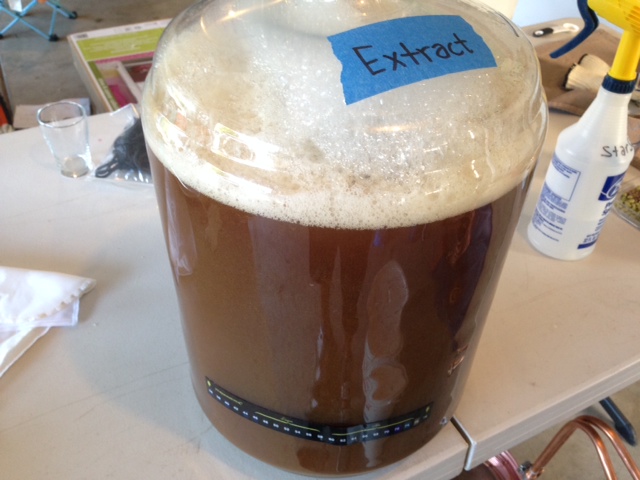
When the boil was complete for the AG batch, it was chilled and racked it to a carboy.
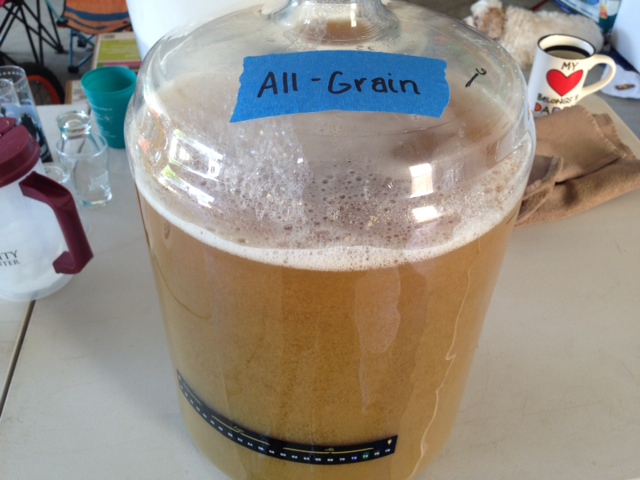
The difference most readily apparent at this point was color. My BeerSmith calculations worked, as the OG for both beers were shockingly spot-on.
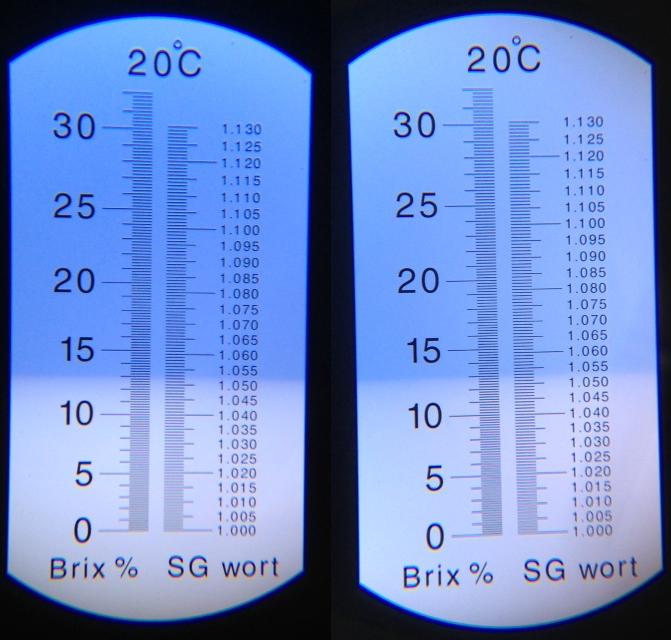
Since my groundwater is so warm this time of year, I was only able to get the wort down to about 72°F using my King Cobra IC (7 minutes), so I moved the carboys to the ferm chamber to chill to my preferred pitching temp of 65°F. After about 3 hours, the worts were chilled and I rehydrated the Nottingham yeast.
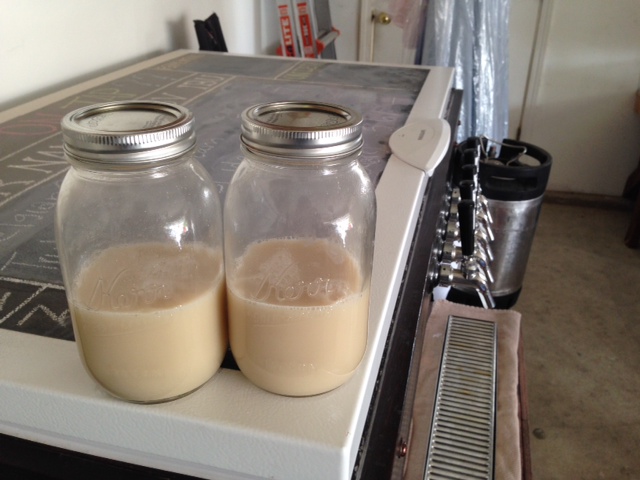
I used to sprinkle dry yeast directly on top of the wort, which I never had fail, though since rehydrating, fermentation seems to become active a bit quicker. A dry vs. rehydrated exBEERiment is on the list.
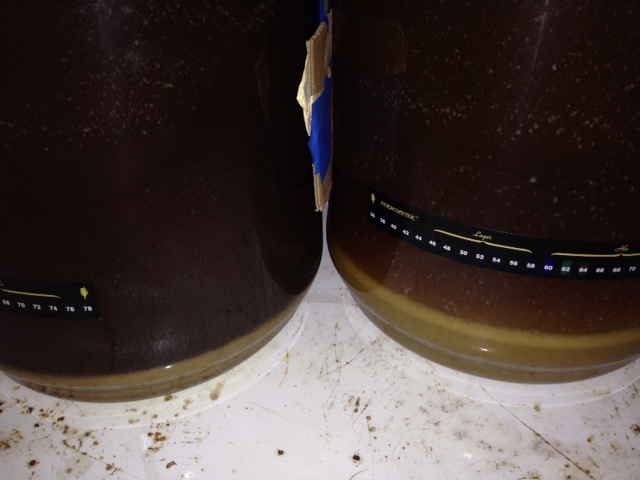
I did not intentionally attempt to put more kettle trub in either carboy, so I’m speculating that some of the hot break of extract is removed during the manufacturing process. The first signs of fermentation were observed the next morning, approximately 17 hours post-pitch.
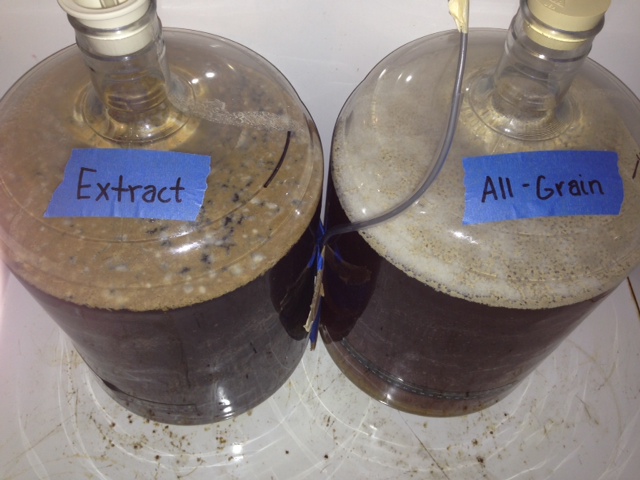
It appeared they were at about the same stage of activity, which was oddly satisfying, though the krausen on each looked remarkably different. A full day in and things were looking a bit less odd.
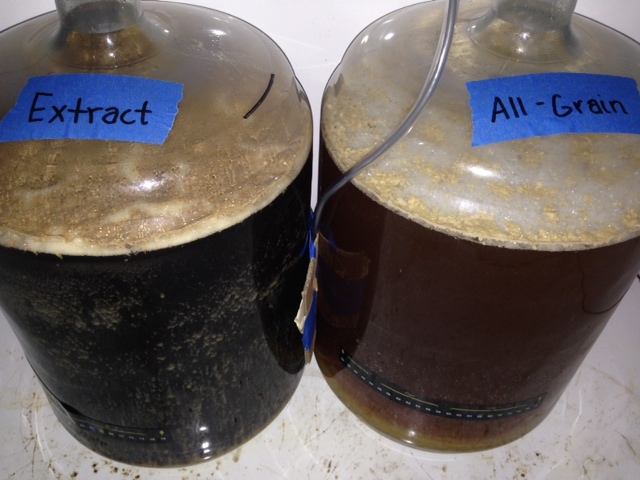
After 2 full days since pitch, the extract krausen seemed to develop much larger bubbles, something I’m not terribly used to. The all-grain krausen looked more like what I usually see. Airlock activity was about the same, though the colors remained noticeably different.
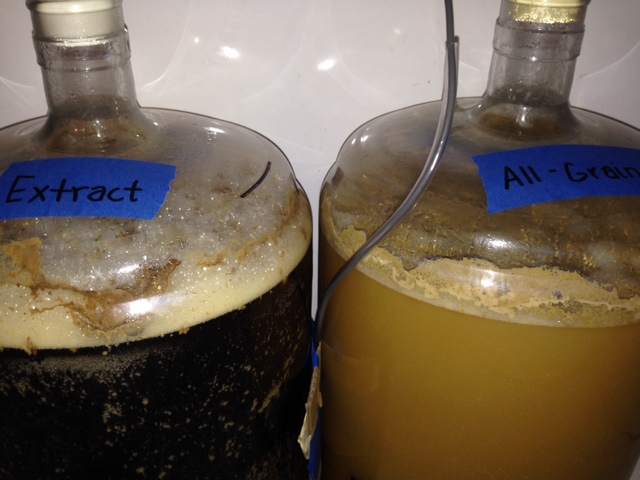
After 3 days, airlock activity was slowing down and the krausen on the all-grain batch had fallen.
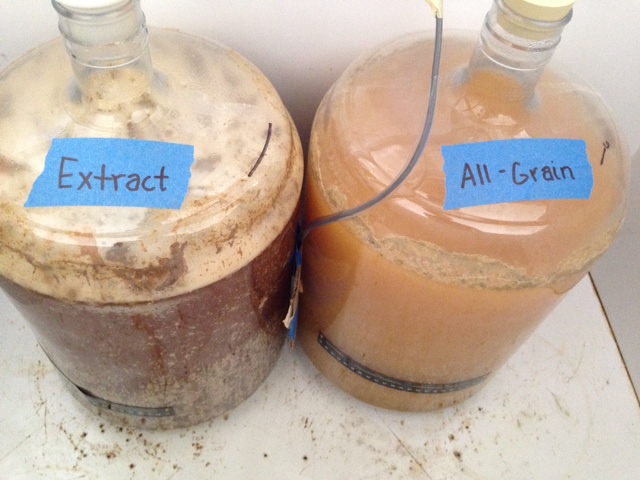
A day later, the top of the extract beer was looking a little more similar to the other one.
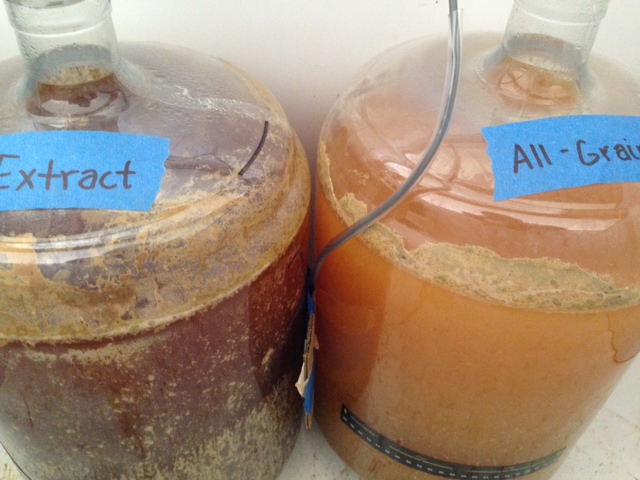
Six days after brewing the beers, with fermentation activity seemingly at a standstill, I took some gravity samples.
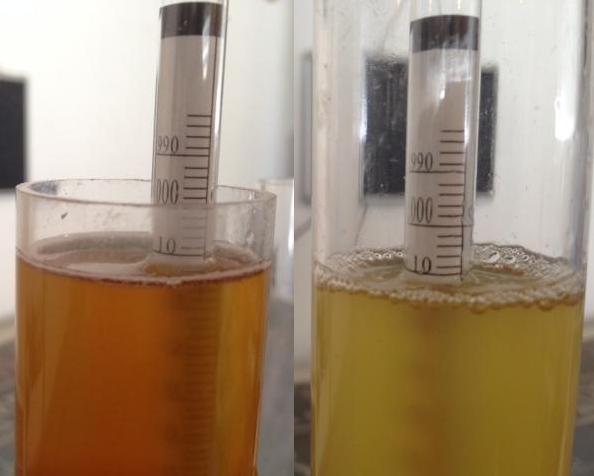
To my eyes, both were sitting right at 1.011. Even in the small hydrometer jar, the color difference was very obvious. I let them sit another 6 days at a warmer temp to allow the yeast to clean-up any off-flavors, then took another gravity sample.
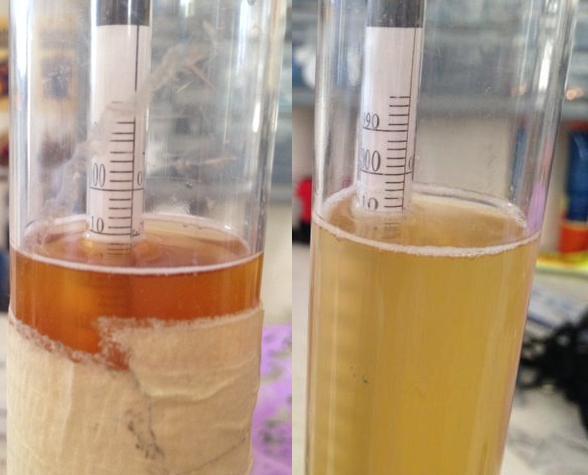
The extract beer was still at 1.011 while the AG beer dropped down to 1.010, which I sort of expected, making me wish I would’ve mashed a bit higher. Whatever, .001 isn’t all that big of a difference. Both beers were crashed to 30°F to clear up, a step that usually takes 36-48 hours, though due to the July 4th holiday and my daughter’s birthday, I left them for 5 days before kegging.
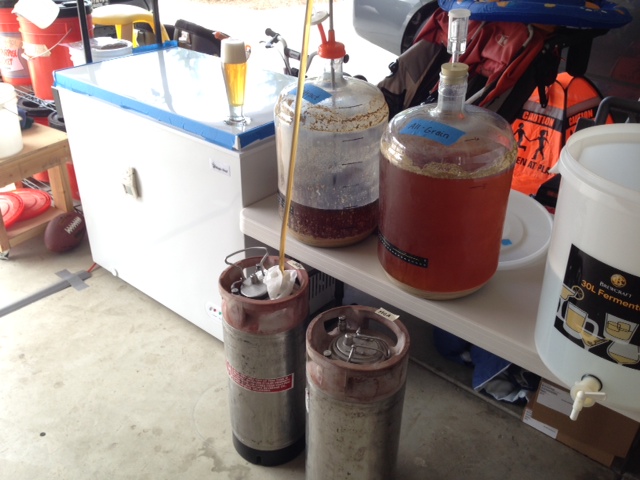
The kegs were placed in my keezer and put through the same forced carbonation routine I always use: 30 psi for ~36 hours then dropped to 12 psi for serving. They sat undisturbed for 8 days prior to being bottled for presentation to the tasting panel at my homebrew club meeting.
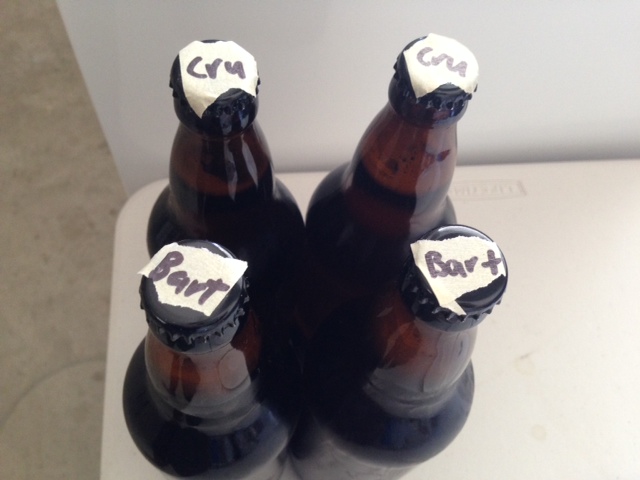
| RESULTS |
Fourteen people participated in the tasting panel (2 groups of 7 participants), none of whom were aware of the nature of the exBEERiment. Participants were text messaged the survey link (feel free to check it out) and asked to complete the survey without talking to the other participants. I stood watch over both groups and ensured there was no collusion. Similar to the last exBEERiment and likely a practice I’ll continue, each beer was designated the name of a character from one of my favorite movies, in this case that movie was Rad.
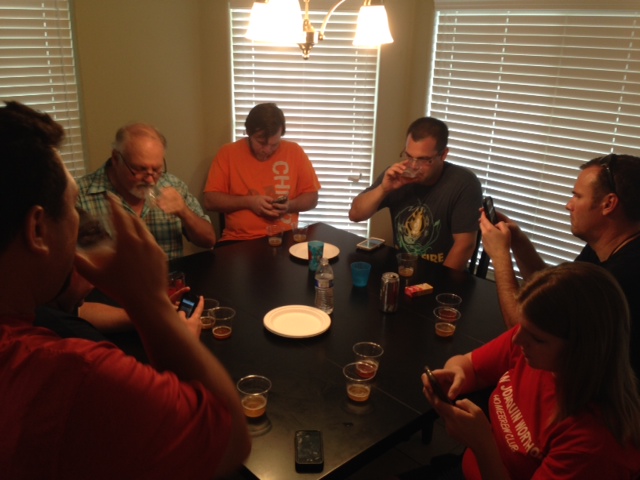
Each participant received 2 clean glasses that were filled with approximately 4 oz of each beer, I was certain to clarify which beer was in each glass and everyone expressed understanding.
Side-note: I received a few recommendations to stop sharing the percentages due to the limited statistical power as a result of a small sample size, something I wholly understand. However, given the growing number of tasting panel participants and the general interest others have expressed, I plan to continue sharing this data and encourage readers to interpret it with a degree of caution. Also, I’ve decided to forgo sharing each participants individual comments, figuring a more cohesive summary would be less cumbersome and potentially more enjoyable to read, particularly as the tasting panel continues to grow.
– 57 % preferred the extract beer and 43% preferred the AG beer (prior to knowing the difference)
– 57% accurately guessed the beer made with extract, 14% said they did not know
Appearance
The most common comment regarding appearance was that the extract beer was darker than the AG beer, which was very obvious. Tasters also generally agreed that the AG was slightly clearer, but that both looked nice and had a similar head. Interestingly, 50% (7) of the tasters thought the extract beer’s appearance was better overall, seemingly due to the darker color, while 1 participant (7%) believed there to be no difference, at least preferentially.
Aroma
The extract beer was described by panel members as having a much more sweet aroma, with some tasters saying is tasted more “malty” and “caramelly” when compared to the AG beer. In describing the AG beer, one taster commented it “smells like a macrobrew” while others experienced the extract beer has having a somewhat “fruity” aroma. Overall, 57% of the participants preferred the aroma of the extract beer with no one claiming there to be no difference.
Flavor
The extract beer was most commonly described as having a sweeter/maltier flavor and being more sharply bitter. Some tasters said they could taste the “actual malt” in the AG beer, though nearly all agreed it was generally lighter/cleaner in flavor. 57% of tasters said they preferred the flavor of the extract beer, with most commenting their preference was due primarily to the sweeter character when compared to the AG beer. Nobody on the panel said there was “no difference” between the 2 beers in regards to flavor.
Mouthfeel
Overwhelmingly, the extract beer was described as having a fuller mouthfeel and more body, with one taster remarking it “lingers longer in my mouth.” The AG beer was most described by most as having a thinner body and less in the realm of overall mouthfeel. While 2 tasters felt there was no difference in mouthfeel between the beers, 50% reported they preferred the mouthfeel of the extract over the AG beer.
General Preference
When asked to select the beer they preferred overall, prior to being informed of the nature of the exBEERiment, 57% (8) of tasters selected the extract beer and 43% (6) selected the AG beer.
Could They Predict the Difference?
One of the questions on the survey asks, “What do you believe is different about the beers you are tasting?” The purpose of this question, which tasters had the option to skip, was to determine if the relatively experienced tasting panel might be able to accurately predict the nature of the exBEERiment. While no one specifically guessed extract vs. all-grain, 57% (8) thought it had something to do with the the grains/malts and 2 tasters postulated the extract beer was basically the AG beer brewed with crystal malts.
Once tasters were made aware of the nature of the exBEERiment, they were asked to predict the beer they believed was made using the malt extract. Of the 57% (8) who accurately predicted the extract beer, 4 commented it was the darker color that gave it away. 29% (4) inaccurately guessed that Cru was the extract beer and 14% (2) said they simply didn’t know which was made with extract.
My Impressions: I started drinking both of these beers a few days prior to presenting them to the tasting panel, attempting my best to evaluate them with as little bias as… yeah right, I’ve neither the desire nor balls to try to claim my evaluation of these beers was unbiased. Rather, I’ll share some of my expectations and personal experiences with each beer.
Being a rather vocal advocate for newer brewers getting into all-grain brewing sooner than later, I certainly had some ideas as to how these beers might turn out, I even wrote some down prior to my own tasting, just to see how they’d match with my perception of the beers once finished. Given the fact the AG beer was made using a single malt, I expected it to be very clean with maybe a slightly perceptible biscuit character from the Maris Otter malt. Since I used Fuggles later in the boil, I thought I might also pick up some earthy and/or floral hop character. The extract beer I expected to have that typical “extract flavor” I usually experience with more caramel notes and a thicker mouthfeel than the AG beer, though I figured the hop character would be about the same. Going into this exBEERiment, I understood the AG beer would most likely have a lighter aroma and flavor with thinner body.
Every time I compared the beers, the most noticeable difference was how the extract beer seemed to have a more prominent bitter bite, which I’ve heard could be due to the way the malt extract is added to the water. As expected, the AG beer was crisper in mouthfeel and certainly lighter in flavor and aroma. Where the extract beer had a rather prominent caramelly maltiness that hid most hop character, the AG beer was subtly nutty with a more noticeable, though still slight, floral hoppiness. Before sharing my personal preference, I’d like to give major kudos to MoreBeer for offering a truly unique product, as the LME used in this exBEERiment far surpassed my expectations and produced a beer I was absolutely unashamed to share. With some specialty malts and the proper techniques, I’ve no doubt some award winning beers can be made with this high quality ingredient.
Personally, I prefer my beer on the dryer side, so I choose the AG beer as the better of the 2. I also liked how the hop character seemed to come through stronger in the AG beer and the crisper mouthfeel made it a bit more easy-drinking. The extract beer had a sharper bitterness and sweeter character, which was fine, just less preferable to me.
| DISCUSSION |
To reiterate, the purpose of this exBEERiment was NOT to prove whether all-grain beers were better than extract beers, but rather to examine whether differences would be perceived between 2 beers made using the same base malt, one in extract form the other all-grain. To these ends, I believe the results of this exBEERiment support the notion that malt extract, at least in liquid form, does produce a unique flavor not found in beers made with all-grain. In discussions with tasting panel participants following completion of the survey, it was suggested that the AG beer would likely have resembled the extract beer more closely had it included a fairly significant dose of a mid-range Crystal malt, with a nationally-ranked BJCP judge suggesting up to 1 lb of C60.
As always, please feel free to comment or ask any questions. Cheers!
Support Brülosophy In Style!
All designs are available in various colors and sizes on Amazon!
Follow Brülosophy on:
FACEBOOK | TWITTER | INSTAGRAM
| Read More |
18 Ideas to Help Simplify Your Brew Day
7 Considerations for Making Better Homebrew
List of completed exBEERiments
How-to: Harvest yeast from starters
How-to: Make a lager in less than a month
| Good Deals |
Brand New 5 gallon ball lock kegs discounted to $75 at Adventures in Homebrewing
ThermoWorks Super-Fast Pocket Thermometer On Sale for $19 – $10 discount
Sale and Clearance Items at MoreBeer.com
If you enjoy this stuff and feel compelled to support Brulosophy.com, please check out the Support Us page for details on how you can very easily do so. Thanks!










18 thoughts on “exBEERiment | Extract vs. All Grain In A Blonde Ale”
Without a doubt my extracts were sweeter and had more fruit aroma when compared to BIAB. There is a distinct taste for extract, but I don’t think everyone can pick up on it.
Great writeup!
Also, Waxwing – Kill the Messenger will never fail to pump me up, thanks for the throwback
Great fucking tune! Starfish is one of the most nostalgic, fist-pumping songs I know. Anything Rocky does is amazing, that dude is pure talent.
good stuff! i didn’t realize he was still pumping out tunes (2010?!). I think Suicide Medicine was the last CD I had of his, but needless to say, im sure its sitting somewhere with a hole in it from the constant usage. i think its time to make another Spotify playlist 🙂 cheers!
You’ve missed out on so much! Definitely take a good listen to his newer stuff, hours of great music.
If you like bikes and tunes check out the movie Seasons.
Hello!
A truly interesting experiment! I recently started reading your blog and I really love the stuff. Especially this experiment and the “truby vs no truby” were spot on!
I have some thoughts about this one though that I’d like to share with you.
When we brew, we normally use a combination between grain and dry malt extract. The main reason we use the extract is that we find that it helps us getting better foam.
When reading a bit about extracts a few week ago, I read something very interesting about how they are manufactured changes their taste. Liquid extracts are made by reducing the liquid in the wort. This process is made as carefully as possible, but apparently, some caramelisation is impossible to avoid. That means that LME will always be slightly caramelised.
So when making this experiment, the LME beer you made, was actually more similar to making an ale with a small addition of caramel malt. When being compared to an AG brew with no caramel malt at all, the difference will be apparent, and those preferring beer with a little red note will likely prefer that one. A more fair test might have been to add some caramel malt to the AG and see if it still is possible to note the difference (but it might be hard to calculate how much caramel is needed)
Further on, dried malt extract should be less sweet, because the method for making spraymalt is more careful and almost no caramelisation (at least so they say) is made. So what could also be very interesting is to see how big the difference would be comparing DME to All-grain, and if you could actually taste that =) So also that might have made a more fair comparison.
Have a nice day!
Good job with the experiment by the way 🙂 Keep up the good work!
Thanks for the detailed and thoughtful response, I think a DME vs. LME exBEERiment may be in my near future 😉
Oh! That would be awesome. Looking forward to that one so I’m holding my thumbs there will be one 😉
Me and a friend actually had a discussion about extracts yesterday. He thought I should use only DME as the base malt to make brewing faster, and I’m kind of moving against using more or only grain…
What I’m most curious about is if DME or LME has any particular “taste” that you can detect compared to All-grain. Like if you could say “This here is an extract beer” rather than saying “This beer is a bit sweeter, or something”. Do you think the results of this exBeeriment indicates that there is no such extract-taste?
Excellent write-up!
I didn’t see it mentioned, but one reason for the more pronounced bitterness in the extract brew could be that you split up the addition of the extract into half at the beginning of the boil and half in the last 15 minutes. It looks like you did a full boil for each (as opposed to topping up the extract with water) so that would mean your Extract batch was at about half the boil gravity as the All Grain batch for the first 45 minutes of the boil. You said you added 25 IBU’s of Magnum for each batch at 60 minutes so maybe your brew software accounted for the different gravities. The next addition at 30 minutes had an equal weight for each batch so perhaps that created enough of a difference in hop utilization for your tasters to notice. If anyone wants to read more about Boil Gravity vs. Hop Utilization, John Palmer explains it nicely here:
http://www.howtobrew.com/section1/chapter5-5.html
Great experiment and very well documented, thanks for sharing!
This is definitely something I considered prior to embarking on this exBEERiment, though I chose to stick with changing only a single variable (malt source). I think a future exBEERiment testing the hop character, parituclarly bitterness, in 2 different extract batches (100% extract for full boil vs. half at 60 + half at 15) would be very interesting.
An idea would be to simply adjust in beersmith the amount of hops to have the same theoretical IBU’s in the end.
Adding both solutions maybe a second round of this exbeeriment adding some crystal malt in the All Grain version (beersmith could help with colour, but not with flavour), and also adjusting hops in the extract version.
Well, one thing I didn’t do was split the extract addition in BS, I just plugged in 8 lbs of extract and the IBU prediction was the same for both batches…
Brulosopher, when you do input the accurate times in BeerSmith it calculates different IBU’s automagically.
I am surprised nobody mentioned longer boil time in the AG batch to compensate for the caramel/maltiness and color of the LME. Don’t know how long (maybe 2 hours?), the color difference seems to be to big, but i think it would be a fairer comparison than adding crystal malt.
Great blog and experimentation! I got to your blog some weeks ago and been looking it up.
Great ExBEERiment! I know this is about 2 years past the last post, but I have a baby due in less than a week, and want to shorten and simplify my brew day, so been doing a lot of research on extract.
I have a feeling that same. exact. nostalgia. is going to hit me with the extract smell. Went to Western, worked with the drummer (Rudy) of waxwing, and started brewing in a small apartment with my roommate. Now i’m stoked.
Thanks Marshall!
Rudy Gajadhar! He drove me to high school for a couple years, his younger brother, Mark, was one of my best friends. In fact, the majority of the music on The Brülosophy Podcast was created by Mark.
My wife, Laura, worked with Rudy in once of the dining areas for awhile, I believe that was in 2001-2002.